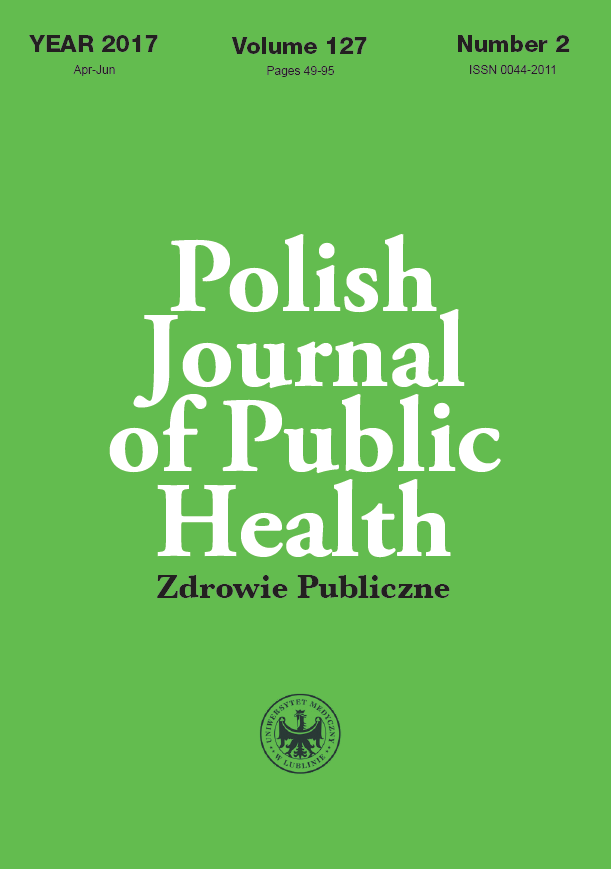Popularity and knowledge concerning complications of body modifications among young adults
DOI:
https://doi.org/10.1515/pjph-2017-0015Keywords:
tattooing, piercing, young adultsAbstract
Introduction. Body modifications are practices leading to transient or permanent change of various parts of human body. The most popular forms of body modifications are tattooing and piercing.
Aim. The aim of the study is to determine the frequency of the most popular body modifications (tattoos and piercing) among young adults aged 18-32 years and to collect and analyze their opinions concerning body modifications and to determine their knowledge about the complications during these procedures.
Material and methods. The study was conducted in February 2017 among 251 individuals: 146 females (58.17%) and 105 males (41.83%). An original questionnaire was used. It consisted of questions about body modifications. Researchers recorded body modifications the respondents have had. Participation in the study was voluntary and anonymous. Participants were randomly selected. Results were analyzed with STATISTICA 12.5 and ANOVA program; p<0.05 was considered statistically significant.
Results. The number of 23 examined individuals (10 men and 13 women) had tattoos (9.16%). The mean number of tattoos was 1.6±0.6 for women and 2±1.1 for men. As many as 128 individuals had ear piercing (51%), including 6 males and 122 females. The number of 13 people (5.18%) had piercing in places other than ears. Piercing is significantly more common than tattooing. As many as 109 individuals (43.43%) did not have tattoos or body piercing. The total number of 106 respondents (42.23%) liked tattoos, ear piercing 168 (66.93%), piercing of other parts of the body 41 (16.33%), and other body modifications 8 (3.19%) individuals. As many as 221 (88.05%) individuals claimed that they knew the complications of body modifications.
Conclusions. Body modifications are popular among young adults, especially among females. The most positively assessed by respondents were earnings and tattoos, what correlates with their occurrence in this group of people. The vast majority of respondents consider that they know the complications of body modifications.
References
1. Oanţă A, Irimie M. Tinea on a Tattoo. Acta Dermatovenerol Croat. 2016;24(3):223-4.
2. Holbrook J, Minocha J, Laumann A. Body piercing: complications and prevention of health risks. Am J Clin Dermatol. 2012;13(1):1-17.
3. Ayanlowo OO, Gold-Olufadi SA, Akinkugbe AO, et al. Growing trend of tattooing and its complications in Nigeria. Int J Dermatol. 2017;56(7):709-14.
4. Randall JA, Sheffield D. Just a personal thing? A qualitative account of health behaviours and values associated with body piercing. Perspect Public Health. 2013;133:110-5.
5. Bone A, Ncube F, Nichols T, Noah ND. Body piercing in England: A survey of piercing at sites other than earlobe. BM. 2008;336:1426-8.
6. Carroll ST, Riffenburgh RH, Roberts TA, Myhre EB. Tattoos and body piercings as indicators of adolescent risk-taking behaviors. Pediatrics. 2002;109:1021-7.
7. Greif J, Hewitt W, Armstrong ML. Tattooing and body piercing. Body art practices among college students. Clin Nurs Res.1999;8:368-85.
8. Balci S, Sari E, Mutlu B. Comparison of risk-taking behaviour and frequency of piercing and tattooing among university students. J Pak Med Assoc. 2015;65(6):587-92.
9. Mayers LB, Chiffriller SH. Body art (body piercing and tattooing) among undergraduate university students: “Then and Now”. J Adolesc Health. 2008;42:201-3.
10. Wohlrab S, Stahl J, Kappeler PM. Modifying the body: motivations for getting tattooed and pierced. Body Image. 2007;4(1):87-95.
11. Szewczyk K. Body piercing as a form of escape into the body. Fam Med Prim Care Rev. 2005;7(2):110-5.
12. Kluger N. Cutaneous infections related to permanent tattooing. Med Mal Infect. 2011;41(3):115-22.
13. Alimohamadi Y, Tabatabaee H, AfsarKazerooni P, et al. Epidemiologic characteristics of HIV-positive patients referring to behavioral diseases consultation center in Shiraz, Iran. Med J Islam Repub Iran. 2014; 28:147.
14. Guiard-Schmid JB, Picard H, Slama L, et al. Piercing and its infectious complications. A public health issue in France. Presse Med. 2000;29(35):1948-56.
Downloads
Published
Issue
Section
License
Copyright (c) 2018 Polish Journal of Public Health

This work is licensed under a Creative Commons Attribution-NonCommercial-NoDerivatives 3.0 Unported License.


